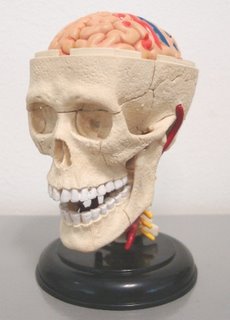 Tomorrow, on the 10th of December, American scientists Dr. Andrew Z. Fire and Dr. Craig C. Mello will be receiving the 2006 Nobel Prize for Physiology and Medicine from the King of Sweden at the Stockholm Concert Hall.
Tomorrow, on the 10th of December, American scientists Dr. Andrew Z. Fire and Dr. Craig C. Mello will be receiving the 2006 Nobel Prize for Physiology and Medicine from the King of Sweden at the Stockholm Concert Hall.They are sharing the prize because they worked together on the same research project, and discovered from their experiments on the worm Caenorhabditis elegans that specific stretches of double-stranded RNA can inhibit the expression of genes effectively (RNA interference). Their finding was published in the prestigious journal Nature in February 1998.
This important discovery increased our understanding of cellular processes, provided an experimental tool for genetics researchers, and formed the basis of a new generation of medicines which have recently completed phase I clinical trials.
We can imagine the mutual joy and excitement of these two colleagues when they receive the prize.
In stark contrast, exactly one hundred years ago in Stockholm, the 1906 Medicine prize was also shared between a pair of scientists, but the mood could not be more different.
The tension in the air was palpable.
That was the first time that the Nobel prize was shared among two recipients. Dr. Santiago Ramon y Cajal and Dr. Camillo Golgi both won the prize “in recognition of their work on the structure of the nervous system”, but in reality these scientists were rivals of each other who believed in opposing theories.
In the late 19th century, there was a controversy in the emerging field of neuroscience. Some scientists believed that the nervous system consists of cells that are linked together in a diffuse, continuous nerve network. This was called the Reticular Theory. Others believed that the nervous system consists of cells called “neurons” which are physically separated by tiny gaps. This was the Neuron Doctrine.
Golgi had invented a chemical process that only stained a small percentage of the nerve cells, so that fine details can be clearly seen under a microscope. Cajal used Golgi’s stain and further improved it, allowing the nerve cell to be seen in its entirety and used these results to support the neuron doctrine. Golgi, on the other hand, firmly believed in the reticular theory and considered Cajal’s results to be inconclusive.
By 1906, although there was strong experimental evidence from many scientists in favour of the neuron doctrine, the Nobel committee for medicine decided to award both Cajal and Golgi.
When delivering his Nobel lecture, Cajal updated the audience on his latest experimental results and noted that:
True, it would be very convenient and very economical from the point of view of analytical effort if all the nerve centres were made up of a continuous intermediary network between the motor nerves and the sensitive and sensory nerves. Unfortunately, nature seems unaware of our intellectual need for convenience and unity, and very often takes delight in complication and diversity.
Golgi however used his lecture to attack the neuron doctrine. He insisted that:
At this point, while I shall come back to this question later, I must declare that when the neuron theory made, by almost unanimous approval, its triumphant entrance on the scientific scene, I found myself unable to follow the current of opinion, because I was confronted by one concrete anatomical fact; this was the existence of the formation which I have called the diffuse nerve network.
While he respected the older Golgi greatly, Cajal was clearly disappointed at Golgi’s behaviour at the ceremony. He later lamented:
What a cruel irony of fate to pair, like Siamese Twins united by the shoulders, scientific adversaries of such contrasting character!
Sadly, this controversy would not be fully resolved until after the deaths of both illustrious scientists. Direct evidence from electron microscopes in the 1950s finally confirmed the presence of tiny gaps, called synapses. The neuron doctrine is correct – Cajal had laid the foundations of modern neuroscience.
It is easy to dismiss Golgi as a stubborn fool. However, if there can only be a winner in this story, then who is it?
Golgi was no less intelligent, hardworking or productive than Cajal. In addition to his contributions to neuroscience, Golgi had also done important research in many areas such as malaria and histology. In fact, he is better known to most life science students because he discovered the Golgi apparatus in 1898, coincidentally one hundred years before the discovery of RNA interference.
Thus, despite their differences of opinion, Cajal and Golgi embody the same spirit of discovery which is also present in their modern counterparts when they receive their prize tomorrow.
But in a much happier mood, of course.
Would you like to know more?
- about how Golgi shared the 1906 Medicine with Cajal
- about other stories of the second best -
1. Swiss vs British Everest teams
2. Steve Jobs vs Bill Gates






3 Comments:
My professor was talking a bit about this a few days ago in my Neurobiology class. Thanks now that it's refreshed in my mind I wont have to study as hard!
Thanks for visiting, Nathan. Hope you get good grades for your Neurobiology class!
aaaaaaand......you've been linked!
Post a Comment